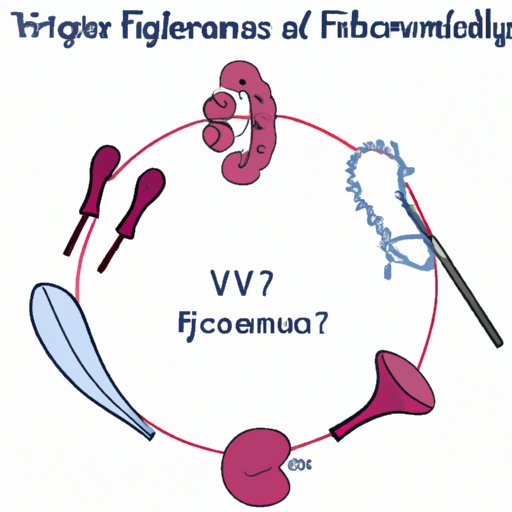
I. Introduction
If you’re wondering if you can get pregnant without fallopian tubes, you’re not alone. Fallopian tubes are an essential part of the reproductive system, and their absence can make conception challenging. But, with advances in modern technology and alternative paths to parenthood, getting pregnant without fallopian tubes is a possibility. This article will explore everything you need to know about getting pregnant without fallopian tubes, including alternative options, success stories, emotional considerations, and tips to increase your chances of getting pregnant after fallopian tube removal.
II. Understanding What the Fallopian Tubes Do and Why Their Absence Means Pregnancy
To understand how to get pregnant without fallopian tubes, you first need to know what they do. The fallopian tubes are two narrow tubes that connect the ovaries to the uterus. During ovulation, the egg is released from the ovary and travels to the fallopian tube, where it can be fertilized by sperm. The fertilized egg then travels down the fallopian tube and into the uterus, where it implants and develops into a viable pregnancy.
If the fallopian tubes are blocked or damaged, the egg may not be able to travel to the uterus, making it difficult to conceive naturally. For women who have had both fallopian tubes removed, pregnancy without medical intervention is impossible.
III. Exploring Alternative Paths to Pregnancy After Fallopian Tube Removal
For women who have had their fallopian tubes removed, there are several alternative options available to consider when trying to conceive. These options include in vitro fertilization (IVF), surrogacy, adoption, and donor eggs.
A. In vitro fertilization (IVF)
IVF is a method of assisted reproduction that involves retrieving eggs from the ovaries and fertilizing them with sperm in a laboratory. The resulting embryos are then transferred to the uterus, where they have the potential to implant and develop into a pregnancy. IVF can be a highly successful method of conception for women without fallopian tubes, with success rates ranging from 40-70%.
B. Surrogacy
Surrogacy is an arrangement in which a woman carries a pregnancy for another individual or couple. This option is often considered by women without fallopian tubes who are unable to carry a child to term themselves. The intended parents can use their own eggs and sperm, or they can use donor eggs and sperm. According to the American Society for Reproductive Medicine, the success rate for surrogacy is typically higher than for other forms of assisted reproduction.
C. Adoption
Adoption is a popular option for individuals or couples who are unable to conceive. While it may not be the first choice for women without fallopian tubes who want to experience pregnancy themselves, adoption is a fulfilling and rewarding alternative path to parenthood.
D. Donor eggs
Donor eggs can be used in conjunction with IVF to achieve a viable pregnancy in women without fallopian tubes. The donor eggs are fertilized with sperm in a laboratory and implanted in the uterus. While it may not be the ideal solution for everyone, donor eggs can make pregnancy possible for women who would otherwise be unable to conceive.
IV. Stories of Women Who Have Successfully Conceived without Fallopian Tubes
If you’re feeling discouraged about your chances of getting pregnant without fallopian tubes, take comfort in knowing that it is possible. Many women have successfully conceived using assisted reproductive technologies or alternative paths to parenthood. Connecting with other women who have gone through a similar experience can be an invaluable source of support and encouragement.
A. Personal experiences of women who have become pregnant after fallopian tube removal
Every woman’s journey is unique, but reading about others’ experiences can provide hope and inspiration. Some women have found success with IVF, while others have chosen surrogacy or adoption. These stories can help you identify which option is right for you and give you the courage to pursue your dreams of starting a family.
B. Their journey to success
The road to parenthood can be long and difficult, especially for women without fallopian tubes. Reading about other women’s experiences can help you gain insight into the process, including the challenges, disappointments, and triumphs that come with trying to conceive using assisted reproductive technology or alternative paths to parenthood.
C. Encouragement and hope for others
Reading about other women’s success stories can provide encouragement and hope for those who may be struggling to conceive after fallopian tube removal. Knowing that it is possible to have a family without fallopian tubes can give women a sense of hope and purpose as they pursue their dreams of starting a family.
V. The Emotional Side of Pregnancy Without Fallopian Tubes
Getting pregnant without fallopian tubes is not just a physical challenge, but an emotional one as well. Women may experience a range of emotions, from sadness and grief to frustration and anger. It’s important to acknowledge and process these emotions, as they can affect your mental health and well-being.
A. Psychological and emotional impact of removal of fallopian tubes
The removal of fallopian tubes can be a difficult and traumatic experience for women. It can leave them feeling less feminine, and questioning their ability to have a successful pregnancy. Processing these emotions with a mental health professional, partner, or support group can be helpful in navigating this difficult time.
B. Ways women deal with the realization
Every woman copes with the loss of fallopian tubes differently. Some may choose to speak with a mental health professional, while others may seek support from family or friends. It’s important to find what works for you and to prioritize self-care during this challenging time.
C. The role of counseling and support
Counseling and support from mental health professionals or support groups can help women process their emotions and cope with the challenges of infertility. It’s important to have a safe space to express your emotions and receive validation and understanding from others who have gone through a similar experience.
VI. How to Increase Your Chances of Getting Pregnant After Fallopian Tube Removal
While getting pregnant without fallopian tubes can be challenging, there are steps you can take to increase your chances of success. These include making healthy lifestyle changes, pursuing fertility treatments, and paying attention to nutrition and exercise.
A. Healthy lifestyle changes
Making healthy lifestyle changes, such as quitting smoking, limiting alcohol consumption, and adopting a healthy diet can improve your chances of conceiving and having a healthy pregnancy. Talk to your healthcare provider about the best ways to make these changes and monitor your progress.
B. Fertility treatments
Fertility treatments, such as IVF, can be highly successful for women without fallopian tubes. Talk to your healthcare provider about which treatments are right for you and your partner.
C. Nutrition
Paying attention to nutrition can improve your overall health and increase your chances of getting pregnant. Make sure to eat a well-balanced diet that includes plenty of fruits, vegetables, lean protein, and whole grains.
D. Exercise
Regular exercise can help improve your overall health and increase your chances of getting pregnant. Talk to your healthcare provider about an exercise plan that is safe and appropriate.

VII. Addressing Common Misconceptions about Pregnancy Without Fallopian Tubes
There are many misconceptions about getting pregnant without fallopian tubes, including whether women can still ovulate, the success rate of IVF, and the chances of a successful pregnancy after fallopian tube removal. It’s important to dispel these myths and understand the facts when considering alternative paths to parenthood.
A. Can women still ovulate?
Yes, women can still ovulate after having their fallopian tubes removed. The eggs are still released from the ovaries, but they cannot travel to the uterus without the fallopian tubes. This is why alternative methods, such as IVF or surrogacy, are necessary for conception.
B. The success rate of IVF
The success rate of IVF varies depending on a number of factors, including age, overall health, and underlying medical conditions. For women without fallopian tubes, the success rate ranges from 40-70% per cycle.
C. The chances of a successful pregnancy after fallopian tube removal
The chances of a successful pregnancy after fallopian tube removal depend on a number of factors, including the woman’s age, overall health, and the method of assisted reproduction used. In general, the success rate of alternative paths to parenthood is high, and many women go on to have healthy pregnancies and babies.
VIII. Conclusion
In conclusion, getting pregnant without fallopian tubes is challenging, but not impossible. Women have a variety of alternative paths to parenthood, including IVF, surrogacy, adoption, and donor eggs. While the emotional side of infertility can be difficult to navigate, counseling and support can help you process these feelings and cope with the challenges. Taking steps to improve your overall health, pursuing fertility treatments, and understanding the facts about conception without fallopian tubes can increase your chances of success. Remember, with hope, persistence, and the right resources, starting a family is possible without fallopian tubes.





